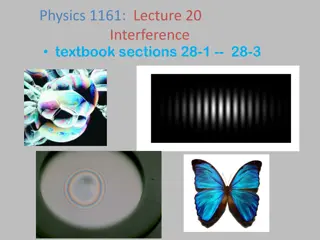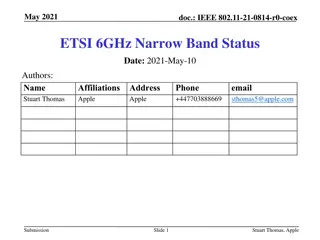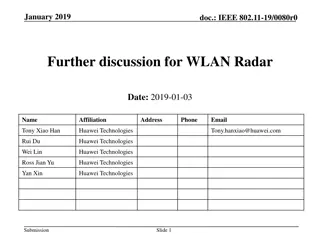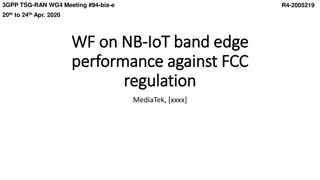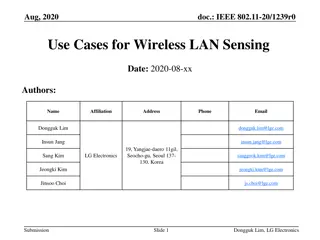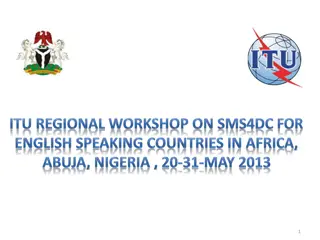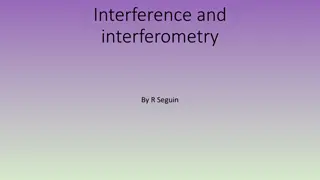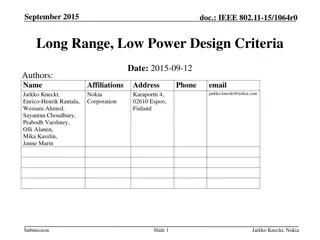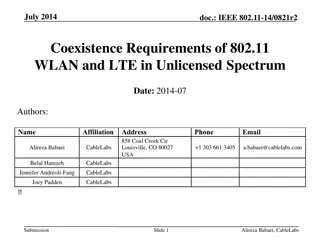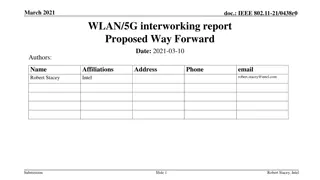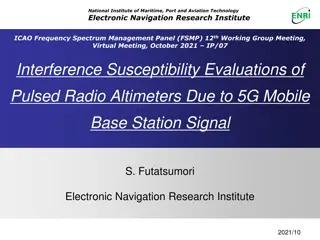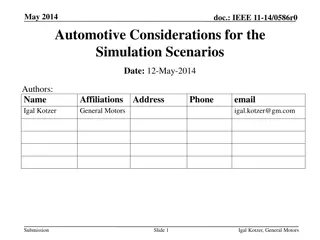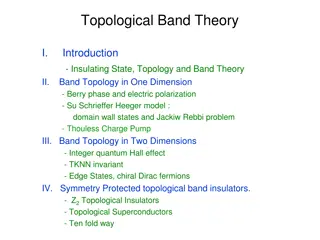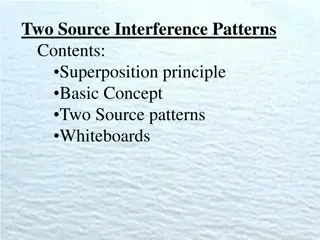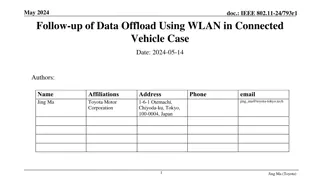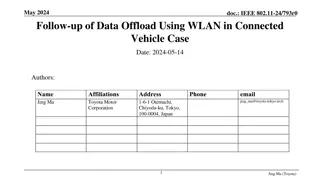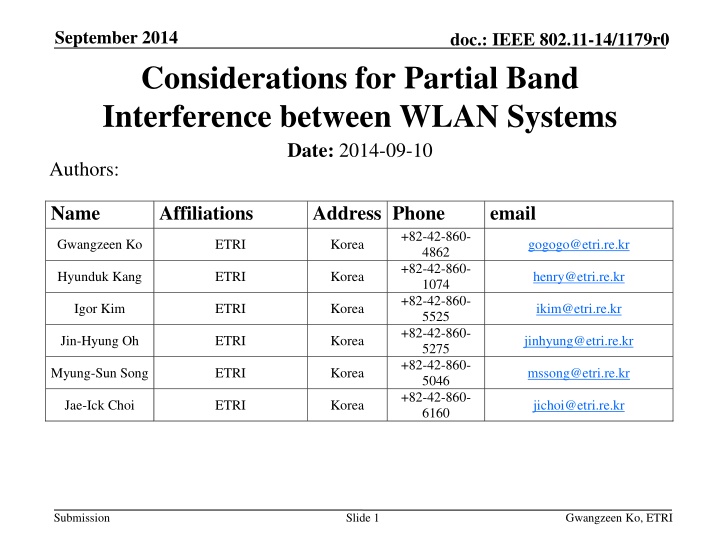
WLAN Interference: Partial Band Considerations
Learn about the impact of partial band interference on WLAN systems and the challenges associated with overlapping BSSs. Discover the difference between full band and partial band interference, along with proposed solutions to improve performance and coexistence in dense deployment scenarios.
Download Presentation

Please find below an Image/Link to download the presentation.
The content on the website is provided AS IS for your information and personal use only. It may not be sold, licensed, or shared on other websites without obtaining consent from the author. If you encounter any issues during the download, it is possible that the publisher has removed the file from their server.
You are allowed to download the files provided on this website for personal or commercial use, subject to the condition that they are used lawfully. All files are the property of their respective owners.
The content on the website is provided AS IS for your information and personal use only. It may not be sold, licensed, or shared on other websites without obtaining consent from the author.
E N D
Presentation Transcript
September 2014 doc.: IEEE 802.11-14/1179r0 Considerations for Partial Band Interference between WLAN Systems Date: 2014-09-10 Authors: Name Affiliations Address Phone email +82-42-860- 4862 +82-42-860- 1074 +82-42-860- 5525 +82-42-860- 5275 +82-42-860- 5046 +82-42-860- 6160 Gwangzeen Ko ETRI Korea gogogo@etri.re.kr Hyunduk Kang ETRI Korea henry@etri.re.kr Igor Kim ETRI Korea ikim@etri.re.kr Jin-Hyung Oh ETRI Korea jinhyung@etri.re.kr Myung-Sun Song ETRI Korea mssong@etri.re.kr Jae-Ick Choi ETRI Korea jichoi@etri.re.kr Submission Slide 1 Gwangzeen Ko, ETRI
September 2014 doc.: IEEE 802.11-14/1179r0 Abstract In the OBSS area, WLAN throughput decrease depending on number of overlapped BSS due to the time sharing policy between WLAN systems. There are two types of interferers between overlapped BSSs. One is full band interference from neighbor BSSs. Another is partial band interference. In this presentation, we will discuss both partial band interference problems and possible solution. Submission Slide 2 Gwangzeen Ko, ETRI
September 2014 doc.: IEEE 802.11-14/1179r0 Introduction Full band interference When two or more devices operation band are fully overlapped. This type of interference is called by Full band interference each others Both center frequency and bandwidth are exactly same Partial band interference When two or more devices operation band are partially overlapped. This type of interference is called by Partial band interference each others Both center frequency and bandwidth are NOT exactly same Submission Slide 3 Gwangzeen Ko, ETRI
September 2014 doc.: IEEE 802.11-14/1179r0 Introduction Full band vs Partial band interference example in 2.4GHz band Partial Bandwidth Overlap CH.1CH.2 CH#2 CH.1 CH.2 CH.3 CH.4CH.5 CH.6 CH.7 CH.8 CH.9 CH.10CH.11CH.12CH.13 15MHz Overlap AP CH#1 2483.5MHz 2400MHz STA 5MHz CH#1 20MHz AP CH#3 STA AP AP STA Partial Bandwidth Overlap Full Bandwidth Overlap CH.3 CH.1 CH.1 10MHz Overlap 20MHz Overlap Submission Slide 4 Gwangzeen Ko, ETRI
September 2014 doc.: IEEE 802.11-14/1179r0 Bandwidth Overlap Problems Because of time sharing policy for coexistence between BSSs called CSMA/CA, bandwidth overlap yields performance degradation. This performance degradation is an expected problem since WLAN was born. However, this simple coexistence protocol is a good solution for bandwidth overlap between BSSs. Solution of this problem will be supported by Functional Requirement of IEEE 802.11ax(TGax R7)[1] The 802.11ax amendment shall provide a mechanism to facilitate frequency reuse and manage interference between neighboring overlapping BSS (OBSS) in dense deployment scenarios with a high density of STAs per BSS or a high density of both STAs and BSSs Submission Slide 5 Gwangzeen Ko, ETRI
September 2014 Difference between Full and Partial Bandwidth Overlap In full bandwidth overlap case, time division solution is available. Whereas, in partial bandwidth overlap case, there are some clean frequency bands additionally. These clean parts of bandwidth are a hiding resource of current WLAN networks. So, if we can use those clean part of bandwidth, WLAN performance can be improved. doc.: IEEE 802.11-14/1179r0 CH.1CH.2 CH.3 CH.1 15MHz Overlap 10MHz Overlap Clean Bandwidth = No WLAN interference Submission Slide 6 Gwangzeen Ko, ETRI
September 2014 Characteristics of Fully and Partially Overlapped Bandwidth Fully overlapped bandwidth Possible : both physical layer detection and NAV information Partially overlapped bandwidth Possible : physical layer detection and expected low signal strength Hard to decode NAV information To detect partial overlap bandwidth accurately, we need modification of existing CCA procedure based on signal characteristics of partial overlap cases. doc.: IEEE 802.11-14/1179r0 Submission Slide 7 Gwangzeen Ko, ETRI
September 2014 doc.: IEEE 802.11-14/1179r0 What about 5GHz? Similar situation in 5GHz band! 20M BW 40M BW 40MHz 20MHz Overlap AP 20MHz STA AP 80MHz STA AP 80M BW 20M BW STA 20MHz Overlap Submission Slide 8 Gwangzeen Ko, ETRI
September 2014 doc.: IEEE 802.11-14/1179r0 Possible Solution for Bandwidth Overlap Problem Non Overlap approach(Level 1) Higher Layer or User Management Government Guide Line for band selection Powerful for 2.4GHz and enterprise devices Providing intelligence initial bandwidth selection and updating mechanism How often? Automatically or User setting? Overlap approach(Level 2) Full band overlap case Time Division Access Partial band overlap case Time and Frequency Division Access OFDMA Submission Slide 9 Gwangzeen Ko, ETRI
September 2014 doc.: IEEE 802.11-14/1179r0 Summary IEEE 802.11ax will support various performance enhancement techniques There are unused resource in the frequency domain which is some clean bandwidth under partially overlapped OBSS situation Usage of these unused bands provides higher performance in IEEE 802.11ax standard Submission Slide 10 Gwangzeen Ko, ETRI
September 2014 doc.: IEEE 802.11-14/1179r0 References [1]Lei Wang et. al.,11-14-0567-07-00ax-proposed-tgax- functional-requirements Submission Slide 11 Gwangzeen Ko, ETRI



